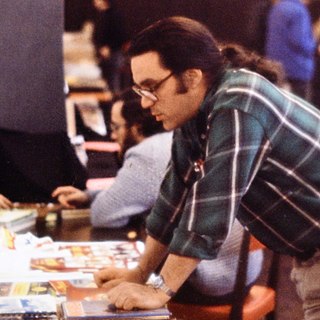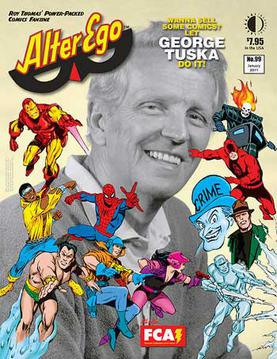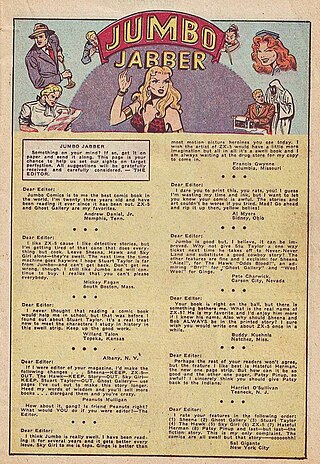Related Research Articles

A fanzine is a non-professional and non-official publication produced by enthusiasts of a particular cultural phenomenon for the pleasure of others who share their interest. The term was coined in an October 1940 science fiction fanzine by Russ Chauvenet and first popularized within science fiction fandom, and from there the term was adopted by other communities.
An amateur press association (APA) is a group of people who produce individual pages or zines that are sent to a Central Mailer for collation and distribution to all members of the group.
The Alley Award was an American annual series of comic book fan awards, first presented in 1962 for comics published in 1961. Officially organized under the aegis of the Academy of Comic Book Arts and Sciences, the award shared close ties with the fanzine Alter Ego magazine. The Alley is the first known comic book fan award.
The Comic Art Convention (CAC) was an American comic book fan convention held annually New York City, New York, over Independence Day weekend from 1968 through 1983, except for 1977, when it was held in Philadelphia, Pennsylvania, and 1978 to 1979, when editions of the convention were held in both New York and Philadelphia. The first large-scale comics convention, and one of the largest gatherings of its kind until the Comic-Con International in San Diego, California, it grew into a major trade and fan convention. It was founded by Phil Seuling, a Brooklyn, New York City, teacher, who later developed the concept of comic-book direct marketing, which led to the rise to the modern comic book store.

Philip Nicholas Seuling was an American comic book fan convention organizer and comics distributor primarily active in the 1970s. Seuling was the organizer of the annual New York Comic Art Convention, originally held in New York City every July 4 weekend throughout the 1970s. Later, with his Sea Gate Distributors company, Seuling developed the concept of the direct market distribution system for getting comics directly into comic book specialty shops, bypassing the then established newspaper/magazine distributor method, where no choices of title, quantity, or delivery directions were permitted.
The Grand Comics Database (GCD) is an Internet-based project to build a database of comic book information through user contributions. The GCD project catalogues information on creator credits, story details, reprints, and other information useful to the comic book reader, comic collector, fan, and scholar. The GCD is a 501(c)(3) nonprofit organization incorporated in Arkansas.
Minicomics Co-ops are entities for trading and promoting small press comics and fanzines. The most well-known of these co-ops is the United Fanzine Organization, or UFO, a co-operative of minicomic creators that has existed since about 1968, when it was called Blue Plaque Publications (BPP). Carl Gafford, at that point the publisher of a comics fanzine called Minotaur, created the BPP; among its earliest members were Chuck Robinson II (publisher of Comique), Dwight Decker (True Fan Adventure Theatre), Ed Romero (Realm), and Gordon Matthews (Coffinworm).
Jerry Gwin Bails was an American popular culturist. Known as the "Father of Comic Book Fandom," he was one of the first to approach the comic book field as a subject worthy of academic study, and was a primary force in establishing 1960s comics fandom.
Batmania is a term coined by Billy Joe (Biljo) White in the early 1960s and the title of his influential fanzine dedicated to the DC comic book character Batman. The name is "almost certainly" a nod to the then-prominent term "Beatlemania" used to describe the impact of the Beatles in popular culture. When White first published Batmania, interest in the Batman character was at a low point; however, due to changes credited largely to DC editor Julie Schwartz, comic sales improved and the character built a wave of popularity that led to the 1966 Batman television series. White and his fanzine were credited with helping to focus the energy of the dedicated fans during this time.

Alter Ego is an American magazine devoted to comic books and comic-book creators of the 1930s to late-1960s periods comprising what fans and historians call the Golden Age and Silver Age of Comic Books.

The Menomonee Falls Gazette was a weekly tabloid published in the 1970s by Street Enterprises that reprinted newspaper comic strips from the United States and the U.K. Comic strips reprinted in this publication normally fell into the adventure and soap opera category. Typically, a full week's worth of a particular strip was collected on a single page of The Gazette. Although The Gazette was available via newsstand distribution, the bulk of their sales came from subscriptions.
William Carl Schelly was an Eisner Award-winning author who chronicled the history of comic books and comic book fandom, and wrote biographies of comic book creators, including Otto Binder, L.B. Cole, Joe Kubert, Harvey Kurtzman, John Stanley, and James Warren as well as silent film comedian Harry Langdon.

A comic book letter column is a section of an American comic book where readers' letters to the publisher appear. Comic book letter columns are also commonly referred to as letter columns, letter pages, letters of comment (LOCs), or simply letters to the editor. Letter columns appeared early on in the history of comic books themselves, and their growing prevalence — particularly beginning in the 1960s — helped create and legitimatize comics fandom. As the forum developed, the volume and tenor of letters became a reliable gauge of overall reader response to developments in the comics themselves. Letter columns remained a regular feature of most comic books until the early years of the 21st century, when they began being phased out in favor of the growing prevalence of email and Internet forums. Despite this, the 2010s saw a renaissance of comic book letter columns, and many comics titles still print them.
Interlac is a bimonthly amateur press association devoted to the DC Comics science fiction superhero team the Legion of Super-Heroes. It was the first APA devoted to the Legion and, despite the decline of APAs due to Internet forums, continues to operate to this day. June 2023 marked the 47th anniversary. The site is named after the fictional language of the same name, which is the primary language used in the comic's setting.

The Comic Reader (TCR) was a comics news-fanzine published from 1961 to 1984. Debuting in the pre-direct market era, TCR was the first regularly published comics industry news fanzine, and was able to secure many contacts from within the ranks of the larger publishers. As TCR increased in popularity and influence, it was able to attract professional artist to illustrate the covers. TCR also proved to be a launching pad for aspiring comic book creators, many of whom published work in the fanzine as amateurs. Contributors from the world of fandom included founding editor Jerry Bails, key editor Paul Levitz, Paul Kupperberg, Tony Isabella, Byron Preiss, Neal Pozner, Don Rosa, Carl Gafford, and Doug Hazlewood.

Rocket's Blast Comicollector (RBCC) was a comics advertising fanzine published from 1964 to 1983. The result of a merger with a similar publication, RBCC's purpose was to bring fans together for the purpose of adding to their comic book collections. It also proved to be a launching pad for aspiring comic book creators, many of whom corresponded and exchanged their work through RBCC, and published work in the fanzine as amateurs.
The Academy of Comic-Book Fans and Collectors (ACBFC) was the first official organization of comic book enthusiasts and historians. Active during the 1960s, the ACBFC was established by Jerry Bails, the "father of comics fandom". A vital player in the development of comics fandom, the ACBFC brought fans of the medium together, administered the first industry awards, and assisted in the establishment of the first comic book fan conventions.
A comic book convention or comic con is a fan convention emphasizing comic books and comic book culture, in which comic book fans gather to meet creators, experts, and each other. Commonly, comic conventions are multi-day events hosted at convention centers, hotels, or college campuses. They feature a wide variety of activities and panels, with a larger number of attendees participating with cosplay than for most other types of fan conventions. Comic book conventions are also used as a method by which publishers, distributors, and retailers represent their comic-related releases. Comic book conventions may be considered derivatives of science-fiction conventions, which began during the late 1930s.

Alan L. Light is a publisher involved in comics and pop culture fandom. He is best known as the founder of The Buyer's Guide for Comic Fandom, which was the longest-running English-language periodical reporting on the American comic book industry.
David A. Kaler is an American writer. He was a primary force in establishing 1960s comic book fandom, particularly through the form of the comics convention. Later, he had a short-lived career as a comics writer for such publishers as Charlton Comics, DC Comics, and Warren Publishing.
References
- ↑ Bails, Jerry G., "America's Four-color Pastime..." The Guidebook to Comics Fandom (Bill Spicer, Summer 1965).
- ↑ Wasserman, J. "Jerry Bails Father of Comic Book Fandom R.I.P: June 26, 1933 - November 23, 2006," CBGXtra.com, November 29, 2006. Retrieved July 15, 2008.
- 1 2 3 Schelly, Bill. "Jerry Bails' Ten Building Blocks of Fandom," Alter Ego vol. 3, #25 (June 2003), pp. 5-8.
- ↑ Caplan, Alan. "50 Years of Comics Fandom," John G. Fantucchio Artwork Gallery (2011). Accessed May 1, 2013.